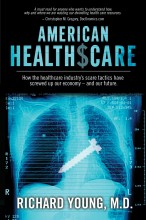LEGAL INDUSTRY
The truth many doctors don’t want to acknowledge is that the direct cost of medical malpractice is a tiny portion of the overall healthcare costs in the U.S., about 0.5%. However, the threat of lawsuits causes doctors to order tests and treatments just to avoid being sued. This issue is very complicated. Is a doctor who orders lots of tests to look for rare causes of a symptom a thorough doctor or one who practices defensive medicine?
INSURANCE COMPANIES
Many other developed countries use private insurance companies to help administer their healthcare systems. However the amount of money U.S. insurance companies skim off the top in administrative costs and profits far exceeds other systems.
One of the unfortunate consequences of the managed care era in the 1990s is that most U.S. insurance companies were converted from non-profit to for-profit.
Why don’t insurance companies do more to become more efficient and help reign in high healthcare costs? I can think of at least three reasons.
- Insurance companies that tried to control costs in the managed care era became hated by the American people, and the companies are in no mood to go through that again.
- Most insurance companies now charge a percentage of each claim. Therefore and inefficient system that encourages patients to make many trips, see many doctors, and have many tests done adds revenue to the insurance companies’ coffers.
- The insurance companies are more beholden to the other large companies (Fortune 500) than many people realize. They do pretty much what the large employers tell them.
DRUG COMPANIES
The pharmaceutical industry has been the most profitable industry in the U.S. over the last few decades. Drug companies have invented some amazing drugs. That’s why they exist — to sell drugs and make a profit. Their success has led to an explosion of drug use in the U.S. Spending on prescription drugs increased from $12 billion to $200 billion between 1980 and 2005, which translates to an average annual increase of 11.9% per year over 25 years.
The drug development industry isn’t as risky as the drug companies want us to believe. In many of their patents, the vast majority of research leading to the development of a new drug was funded by the NIH and foundations, not the companies. The drug companies real revenue generator isn’t their research departments, it’s their marketing departments. They spend more than twice as much on marketing as they do research and development. They spend more on advertising to doctors and patients each year than cost of all medical education in the U.S.
MEDICAL DEVICE COMPANIES
These companies are discussed in the section under Government on the FDA.
MEDIA
The media contributes to expensive healthcare by seeking out certain types of stories that are easy to tell and look good on TV.
- The Rat story: Reporters love to interview scientists at medical schools and universities who think they’ve made big breakthroughs that could possibly lead to a new test or treatment way in the future. TV reporters love to set up these scientists with images of test tubes or rats in a cage in the background. The reporters rarely go back years later to see if the scientist’s discovery turned into anything useful.
- The You-Could-Be-At-Risk story: Reporters love to interview so-called experts who claim that some toxin in the air, water, or food could “put you at risk” for a disease such as cancer or heart disease. Reporters rarely put the supposed risk in context with other risks people commonly take in their daily lives and they rarely question if there is any proof that anyone can do anything about the risk.
- The Know-Your-Number story: This story is the first cousin to the You-Could-Be-At-Risk story. At the conclusion of the story, the reader or viewer is admonished to run to their doctor to have some test so they can be told their personal number. Reporters rarely question the expert pushing the test if there is any evidence that lowering a number with some treatment actually improves health.
- The Suffering-Person-Versus-The-System story: We are all inspired by people who overcome adversity. Telling the story from the point of view of a person with a severe disease is easy and emotional. Too often these stories end with one or more of the following unsubstantiated claims — most doctors don’t know about this rare disease and need more education about it, an expert claims that he is close to a treatment or cure and just needs more research money, people need to run out be tested so the disease can be caught early.



Recent Comments